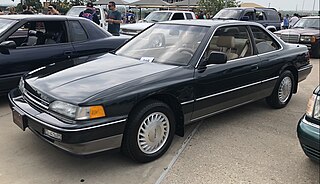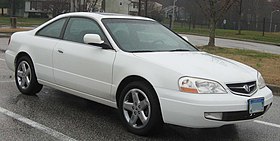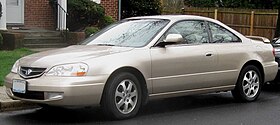
Acura is the luxury and performance division of Japanese automaker Honda, based primarily in North America. The brand was launched on March 27, 1986, marketing luxury and performance automobiles. Acura sells cars in the United States, Canada, Mexico, Panama, and Kuwait. The company has also previously sold cars in Mainland China, Hong Kong, Russia, and Ukraine. Plans to introduce Acura to the Japanese domestic market in the late 2000s did not eventuate due to the financial crisis of 2007–2008.

The Honda Integra, sold in North America as the Acura Integra and later the Acura RSX, is an automobile produced by the Japanese company Honda from 1985 until 2006, and then since 2021. It succeeded the Quint as a more luxurious and sport-oriented derivative of the Civic. The Integra was one of the launch models for Acura in the US in 1986 alongside the Acura Legend. Throughout its production run, the Integra was highly regarded for its handling and performance. The 1995–2001 Integra Type R is widely regarded as one of the best front-wheel-drive cars of all time.

The Honda Accord, also known as the Honda Inspire in Japan and China for certain generations, is a series of automobiles manufactured by Honda since 1976, best known for its four-door sedan variant, which has been one of the best-selling cars in the United States since 1989. The Accord nameplate has been applied to a variety of vehicles worldwide, including coupes, station wagons, hatchbacks and a Honda Crosstour crossover.

The Acura TSX is a compact executive car manufactured by Honda and sold through its Acura division from 2003 to 2014. The TSX spanned two generations, both derived from the corresponding Japanese/European versions of the Honda Accord, which were more compact and sporting-oriented than their larger North American counterpart. The latter Accord platform was also used for the Acura TL, which slotted above the TSX in Acura's lineup. All TSXs were built in Sayama, Saitama, Japan.

The Acura TL is a car that was manufactured by Acura, the North American luxury division of Honda. It was introduced in 1995 to replace the Acura Vigor and was badged for the Japanese-market from 1996 to 2000 as the Honda Inspire and from 1996 to 2004 as the Honda Saber. The TL was Acura's best-selling model until it was outsold by the MDX in 2007. In 2005, it ranked as the second best-selling luxury sedan in the United States behind the BMW 3 Series, but sales decreased after the 2008 model year. Four generations of the Acura TL were produced, with the final fourth generation TL premiering in 2008 as a 2009 model and ending production in 2014, when it was replaced together with the TSX by the TLX.

The fourth-generation Honda Integra, produced by Honda, was introduced in Japan on 13 April 2001 and produced from July 2001 until August 2006. It was introduced in North America on 2 July 2001 as the Acura RSX, the name a part of Acura's naming scheme changing the names of its models from recognizable names like "Integra" or "Legend" to alphabetical designations in order for buyers to build more recognition to the marque, and not the individual cars.

The Honda NSX, marketed in North America as the Acura NSX, is a two-seater, rear mid-engined, rear-wheel drive sports car manufactured by Honda.

The Acura Legend is a mid-size luxury car manufactured by Honda from Japan. It was sold in the U.S. and Canada under Honda's luxury brand, Acura, from 1985 until 1995. It was the first flagship sedan sold under the Acura nameplate, until being renamed in 1996 as the Acura 3.5RL. The 3.5RL was the North American version of the KA9 series Honda Legend.

The Oldsmobile Achieva is a front-wheel drive compact sedan and coupe that was introduced by Oldsmobile for the 1992 model year. The Achieva was based on the GM N-body platform, which it also shared with its siblings the Pontiac Grand Am and Buick Skylark. The Achieva replaced the GM N-body Cutlass Calais after its final 1991 model year, and ended production after the 1998 model year.

The Pontiac Grand Am is a car model that Pontiac Division of General Motors produced in various years between 1973 and 2005. The first and second generations were RWD mid-size cars built on the LeMans GM A platform. The Grand Am name was reused for a FWD compact car for the third- and fourth-generations. The fifth-generation versions was enlarged to a mid-size car.

Honda's first production V6 was the C series; it was produced in displacements from 2.0 to 3.5 liters. The C engine was produced in various forms for over 20 years (1985–2005), having first been used in the KA series Legend model, and its British sister car the Rover 800-series.

The J-series is Honda's fourth production V6 engine family introduced in 1996, after the C-series, which consisted of three dissimilar versions. The J-series engine was designed in the United States by Honda engineers. It is built at Honda's Anna, Ohio, and Lincoln, Alabama, engine plants.

The seventh-generation Honda Civic is an automobile produced by Honda from 2000 until 2005. It debuted in September 2000 as a 2001 model. Its exterior dimensions stayed similar to the outgoing predecessor, with interior space significantly increased, bumping it up to the compact car size designation. A notable feature was the flat rear floor that gave better comfort to the rear seat passengers. This generation abandoned the front double wishbone suspension, used previously from fourth to sixth generations, replacing it with MacPherson struts. This generation was the last to offer 4WD variants.

The eighth generation Honda Accord for Japanese and European markets is a mid-size car. It went on sale in mid 2008 for the 2009 model year. The Japanese-built Accord is also sold in Australia and New Zealand as the Accord Euro. It is also available in US, Canada, and Mexico as the second-generation Acura TSX. From late 2009, it is available as Honda Spirior in China. While not as large as the North American Accord, sold in Japan as the Honda Inspire, this generation Accord is not in compliance with Japanese Governments regulations concerning exterior dimensions, and is not classified as a compact sedan in Japan.

In the U.S., the seventh generation North American Honda Accord is a mid-size car that was available as a four-door sedan or a two-door coupe and was produced by Honda from September 2002 to 2007. The sedan was also marketed in parts of Latin America, Asia, Middle East, Caribbean, Australia and New Zealand markets, and also known as the Honda Inspire in Japan from 2003. The North American Honda Accord, with modifications for local market needs, was the launch vehicle of Honda in the South Korean market with sales beginning from May 20, 2004.

The Acura ILX is a compact car (C-segment) manufactured and marketed by Honda under the Acura brand, based on the ninth-generation Civic sedan. The ILX replaced the Canadian market exclusive Acura CSX. The gasoline-electric hybrid version was Acura's first.

The first generation Honda NSX, marketed in North America and Hong Kong as the Acura NSX, is a 2-seater, mid-engine sports car that was manufactured by Honda in Japan from 1990 until 2005.
The sixth-generation Honda Accord was available as a four-door sedan, a two-door coupe, five-door hatch and station wagon and was produced by Honda from September 1997 until 2002 and from 1998 to 2003 in Europe.
The A-Spec and Type-S marques represent the high-performance divisions of cars produced by Acura. The first vehicle offered as a Type-S variant was the 2001 Acura CL, and the first vehicle offered as an A-Spec variant was the 2003 Acura TL in Canada and the 2002 Acura RSX in the US.























